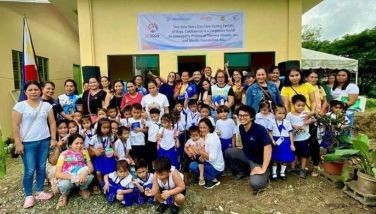Phl urged to tap S&T to boost coastal management
MANILA, Philippines - Filipino and Japanese scientists urged the use of science and technology findings to boost policies affecting coastal areas in the Philippines.
“We agreed to share our research results with local policy makers to help them revisit their investment plans, ordinances, and policies affecting coastal areas,” said Dr. Miguel Fortes, project manager of the Coastal Ecosystem Conservation and Adaptive Management under Local and Global Environmental Impacts in the Philippines (CECAM) at the 2nd National Conference and Workshop of Philippine-Japan Collaborative Project (NCW) held at the University of the Philippines Marine Science Institute (UP-MSI) recently.
Said workshop is an activity under CECAM, an on-going five-year research program supported by the Japan International Cooperation Agency (JICA) and the Japan Science and Technology Agency (JST).
“The workshop aims to create a sustainable development strategy for the Philippines,” said Takahiro Morita, JICA Senior Representative. “Results of the workshop will be shared with other cities and municipalities in the Philippines where coastal waters are threatened by human activities.”
Initial CECAM studies point to inappropriate resource management interventions resulting in biodiversity losses, water pollution, fish kills, and coastal erosion as factors in endangering the coastal environment.
One of the conservation strategies presented by a team of Japanese and Filipino researchers from Tokyo Institute of Technology, Keio Research Institute, University of the Philippines Diliman and Visayas in Iloilo pressed for a watershed management plan to address impact of typhoons and storm surges, particularly in coastal areas.
Based on the study, water elevation in coastal areas like the Banate Bay in Iloilo, Panay Island can reach up to 3.5 meters during strong typhoons. This is mainly due to the storm surges but somehow, forest degradation also magnifies the impact that leads to flooding and severe damage to agriculture lands.
"By using science, we can address the vulnerability of certain coastal areas to storm surge of Typhoon Yolanda level,” said Japanese researcher Masaya Yoshikai during his presentation.
In the aftermath of Typhoon Yolanda, more than 1,200 farmers in Banate Bay were severely affected. Vast tracts of agriculture lands and paddy fields were destroyed, depriving farmers of their income source. Research showed that the damage amounted to some P5M and reduced yield by 60%.
Yoshikai used watershed and computer-based hydro-dynamic modeling to assess impact of deforestation and storm surge scenario in Banate Bay.
“Our simulations showed that floods will be more serious if deforestation continues in the Alacaygan river watershed in Iloilo,” added Yoshikai. “Analysis of land cover and evaluation of forest value should be considered in coming up with a watershed management plan.”
Other conservation strategies recommended during the workshop include, (1) implementation of a comprehensive regulatory policy and stronger enforcement on limiting the number of fish cages in Bolinao, Pangasinan; (2) inclusion of mangrove and seagrass areas as part of marine protected areas to protect the fish species in Northern Mindanao; and (3) strict enforcement of waste water treatment and coral reef protection through educational campaigns and stiff penalties to sea vessels plying coral sites in Boracay Island and Puerto Galera.
The Philippines has abundant marine resources that are vital to key industries such as the marine culture and tourism industry. A report from the Department of Environment and Natural Resources (DENR) noted that the Philippines has about 228 key biodiversity areas covering 7.6 million hectares, including 128 terrestrial and 100 marine sites.
Under the CECAM initiative, coastal areas earlier mentioned were identified as study sites of the project.
- Latest




























